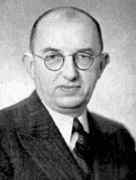Person: Kloosterman, Hendrik Douwe

Hendrik Douwe Kloosterman was a Dutch mathematician, known for his work in number theory and representation theory.
Mathematical Profile (Excerpt):
- Hendrik was brought up as a young boy in the village of Rottevalle which is a small farming village.
- After graduating from the high school in 1918, Kloosterman entered the University of Leiden.
- Hendrik Lorentz, although officially retired from 1912, continued to lecture at Leiden and his successor Paul Ehrenfest was an outstanding theoretical physicist whose friends Niels Bohr and Albert Einstein were frequent visitors to Leiden.
- Of Kloosterman's mathematics lecturers, Kluyver and van der Woude, it was mainly the former that had a strong influence on the young student.
- Kloosterman continued his studies at Leiden with J C Kluyver as the supervisor of his number theory thesis.
- After Kloosterman arrived in Leiden, rigorous analysis had been established there, and in a short time he proved himself a true master in this field.
- It was Ehrenfest, however, who looked after Kloosterman as he would his own students, making sure that he had the opportunity to study with the experts on the subject of his thesis.
- The topic which Kloosterman was working on for his doctorate was concerned with Waring type problems.
- Again it was due to Ehrenfest that Kloosterman was able to visit Hardy in Oxford.
- Kloosterman presented his doctoral thesis to the University of Leiden in 1924.
- In this paper Kloosterman introduced what are today called 'Kloosterman sums'.
- After receiving his doctorate, Kloosterman was required to undertake military service which he did during 1924-25.
- During his visit to Hamburg, Kloosterman applied his idea of 'Kloosterman sums' to obtain estimates for the Fourier coefficients of modular forms.
- After this two years of travel, Kloosterman was offered a post at the University of Münster.
- Kloosterman turned out to be an exceptional teacher.
- This in fact presented an opportunity to Kloosterman to undertake research since he had no teaching duties.
- Kloosterman solved the general case in two papers The behaviour of general theta functions under the modular group and the characters of binary modular congruence groups which occupy 130 pages of the Annals of Mathematics in 1946.
- When the University of Leiden reopened in the middle of 1945, Kloosterman continued to teach an advanced course each year.
- Kloosterman was convinced of the unity of mathematics and in his lectures he stressed the connections between different areas.
- In fact, to attend a lecture of Kloosterman, elementary or advanced, was always a pleasure, both for mathematicians and non-mathematicians.
- Kloosterman did outstanding work building up the Leiden Mathematical Institute and also in expanding mathematics at Leiden by being able to set up several new chairs in pure and applied mathematics.
- In 1954 the International Congress of Mathematicians was held in Amsterdam and Kloosterman was chairman of a small committee with the task to draw up a report on structure and regulations of the Congress.
- It is such an important refinement that some even refer to the circle method as the Hardy-Littlewood-Kloosterman method.
- This refinement led him to the Kloosterman sums.
- Kloosterman sums find their applications in many proofs of results in automorphic forms, L-functions, quadratic forms ...
- Let us mention two honours given to Kloosterman.
- In 1986 the Department of Mathematics at the University of Leiden founded the Kloosterman Chair.
Born 9 April 1900, Rottevalle, The Netherlands. Died 6 May 1968, Leiden, The Netherlands.
View full biography at MacTutor
Tags relevant for this person:
Origin Netherlands
Thank you to the contributors under CC BY-SA 4.0! 

- Github:
-

- non-Github:
- @J-J-O'Connor
- @E-F-Robertson
References
Adapted from other CC BY-SA 4.0 Sources:
- O’Connor, John J; Robertson, Edmund F: MacTutor History of Mathematics Archive
